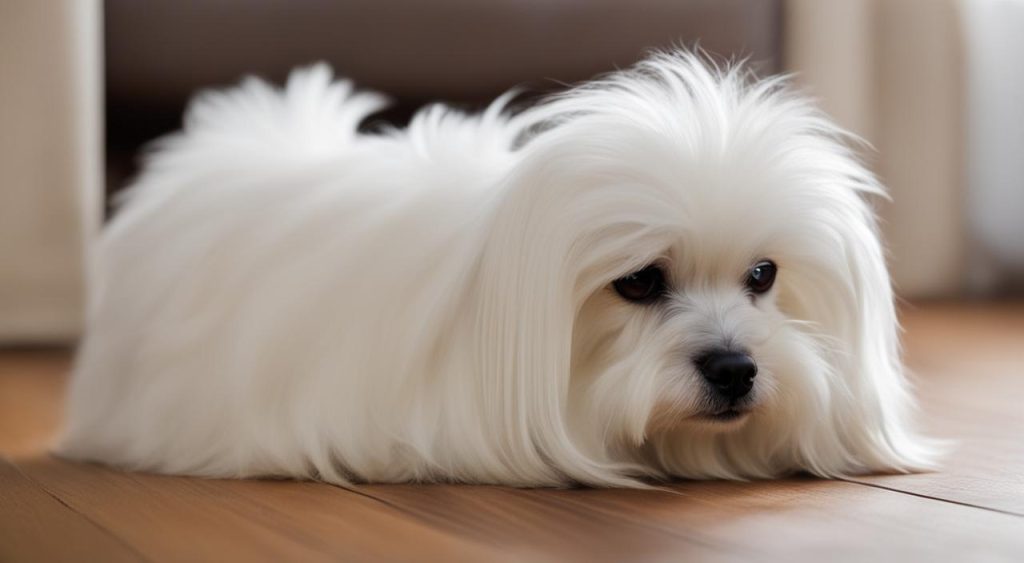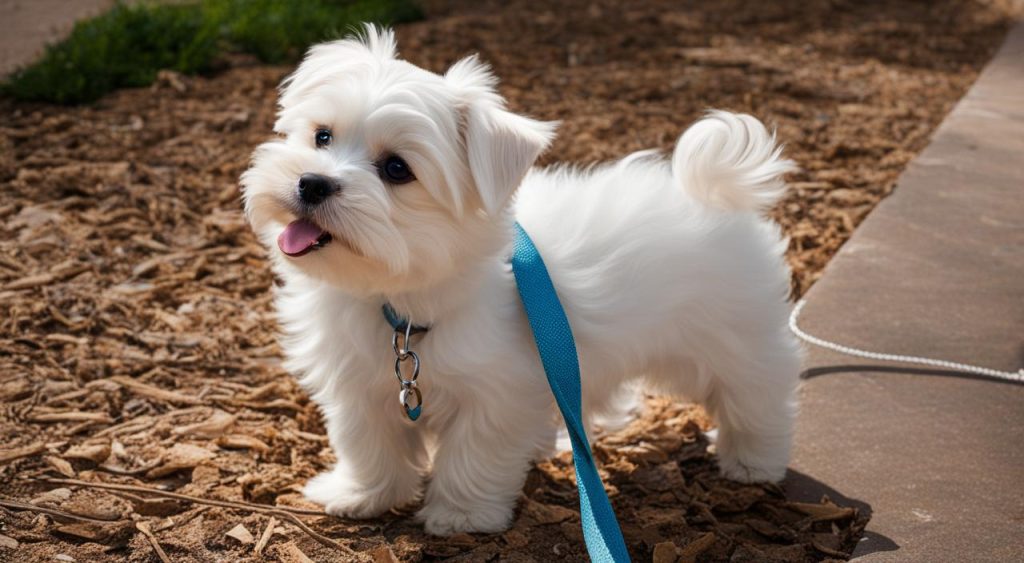Maltese dogs are known for their beautiful, long, silky, white coats. If you’re considering adding a Maltese dog to your family, you may be wondering about their shedding habits. Do Maltese dogs shed a lot? Let’s find out.
While Maltese dogs do shed, it is minimal compared to many other breeds. Their single coat lacks an undercoat, which is why their shedding is less noticeable. Regular brushing and grooming are essential to prevent matting and keep their coat looking its best. Additionally, excessive shedding in Maltese dogs could be a sign of stress or an underlying health condition, so it’s important to seek the advice of a veterinarian if you notice any unusual shedding patterns.
Key Takeaways:
- Maltese dogs have a minimal shedding compared to other breeds due to their single coat without an undercoat.
- Regular brushing and grooming are necessary to prevent matting and maintain the beauty of their coat.
- Excessive shedding in Maltese dogs may indicate stress or an underlying health condition, and veterinary attention should be sought.
- Maltese dogs are hypoallergenic, making them a suitable choice for individuals with mild dog allergies.
- A balanced diet and regular veterinary check-ups contribute to overall coat health and reduced shedding.
Maltese Coat Care and Grooming Tips
The Maltese coat requires regular care and grooming to keep it looking magnificent. Daily brushing is essential to prevent matting and keep shedding to a minimum. Regular baths every 2-3 weeks and trimming of hair around the eyes and ears are also important. Using a sensitive skin shampoo and high-quality grooming tools, such as a pin brush with protective bubble tips, is recommended. Omega fatty acids supplements can improve coat health. Maintaining a balanced diet and monitoring stress levels can also help reduce shedding in Maltese dogs.
Maltese Shedding Frequency and Allergies
Maltese dogs are considered hypoallergenic due to their shedding frequency and coat characteristics. They have a single coat without an underlayer that holds onto dander. While they do shed a little, it is minimal compared to other breeds. This makes them a suitable choice for people with mild dog allergies.
However, it’s important to note that no dog breed is entirely hypoallergenic. Individual sensitivities to pet allergies may vary. Some people may still experience allergic reactions to Maltese dogs, particularly if they are highly sensitive to dander or have severe allergies.
Grooming plays a crucial role in reducing the risk of allergic reactions. Regular brushing helps remove loose hairs and dander from the coat, preventing them from spreading in the environment. Additionally, bathing the Maltese dog every few weeks helps keep their coat clean and minimizes the accumulation of dander.
Keeping the home clean is another important aspect of managing allergies in Maltese dogs. Regular vacuuming, dusting, and washing of bedding can significantly reduce the presence of allergens in the living environment.
In conclusion, while Maltese dogs have a low shedding frequency and are considered hypoallergenic, it’s crucial to remember that individual sensitivities to dog allergies may vary. Regular grooming and maintaining a clean environment can help minimize the risk of allergic reactions for both the Maltese dog and their owners.
Common Health Issues and Shedding in Maltese Dogs
Maltese dogs are generally healthy, but like any breed, they can be prone to certain health issues that owners should be aware of. Some common health conditions that can affect Maltese dogs include reverse sneezing, collapsed trachea, white dog shaker syndrome, luxating patella, and progressive retinal atrophy.
Reverse sneezing is a common condition in Maltese dogs and can be alarming for owners. It is characterized by sudden, rapid inhalation through the nose, often accompanied by snorting or gagging sounds. This condition is usually harmless and resolves on its own, but it’s always a good idea to consult a veterinarian to rule out any underlying issues.
Another health issue that can affect Maltese dogs is a collapsed trachea. The trachea, or windpipe, becomes weakened and narrows, making it difficult for the dog to breathe properly. Symptoms of a collapsed trachea may include a honking or wheezing sound when the dog breathes, coughing, and exercise intolerance. Treatment options may include medication, weight management, and in severe cases, surgery.
White dog shaker syndrome is a condition that primarily affects small, white dog breeds, including the Maltese. It is characterized by tremors and shaking and is believed to be a neurological disorder. The exact cause is unknown, but it is thought to be related to an autoimmune response. Treatment often involves medication to manage the symptoms.
Luxating patella, also known as a dislocated kneecap, is another common health issue in Maltese dogs. It occurs when the kneecap moves out of its normal position, causing pain and lameness. Depending on the severity of the condition, treatment options may include medication, physical therapy, or surgery.
Progressive retinal atrophy (PRA) is an inherited eye disease that can lead to blindness in Maltese dogs. It is characterized by the degeneration of the retina, which affects vision over time. Regular eye examinations and genetic testing can help identify potential carriers of the disease and allow for preventive measures.
In addition to these specific health issues, Maltese dogs may also be susceptible to more common conditions seen in dogs, such as allergies, ear infections, gastrointestinal issues, irritated skin, and elevated liver enzymes. According to insurance claims data, these are some of the top health conditions reported in Maltese dogs.
Regular veterinary check-ups, proper nutrition, and a healthy lifestyle can help minimize the risk of these health issues. Pet insurance can provide financial support to manage the costs associated with consultations, diagnostic tests, treatments, and surgeries, should they be necessary.
Protecting Your Maltese’s Health
As a responsible owner, it’s important to be aware of the potential health issues that can affect your Maltese dog. By staying proactive and seeking veterinary care when needed, you can help ensure your furry friend lives a long and healthy life. Regular grooming, dental care, and providing a balanced diet are also essential for their overall well-being.
Conclusion
Maltese dogs may shed, but their shedding frequency is minimal compared to other breeds. This is attributed to their single coat and lack of an undercoat. To ensure that your Maltese’s coat remains healthy and mat-free, regular grooming practices such as brushing, bathing, and trimming are essential. By monitoring your Maltese’s health and promptly addressing excessive shedding or any concerning symptoms, you can maintain a beautiful coat with minimal shedding.
Caring for a Maltese’s coat requires dedication and attention to detail. Regular brushing helps to remove loose and dead hair, preventing it from accumulating and causing matting. This also ensures that your pet’s coat remains clean and free from tangles. Bathing your Maltese every 2-3 weeks using a high-quality shampoo formulated for sensitive skin can promote coat health and reduce shedding.
In addition to grooming, managing your Maltese’s overall health can also minimize shedding. Providing a balanced diet that supports coat health, including omega fatty acid supplements, can contribute to a lustrous and healthy coat. Monitoring stress levels and ensuring a calm and comfortable environment for your Maltese can also help manage shedding.





